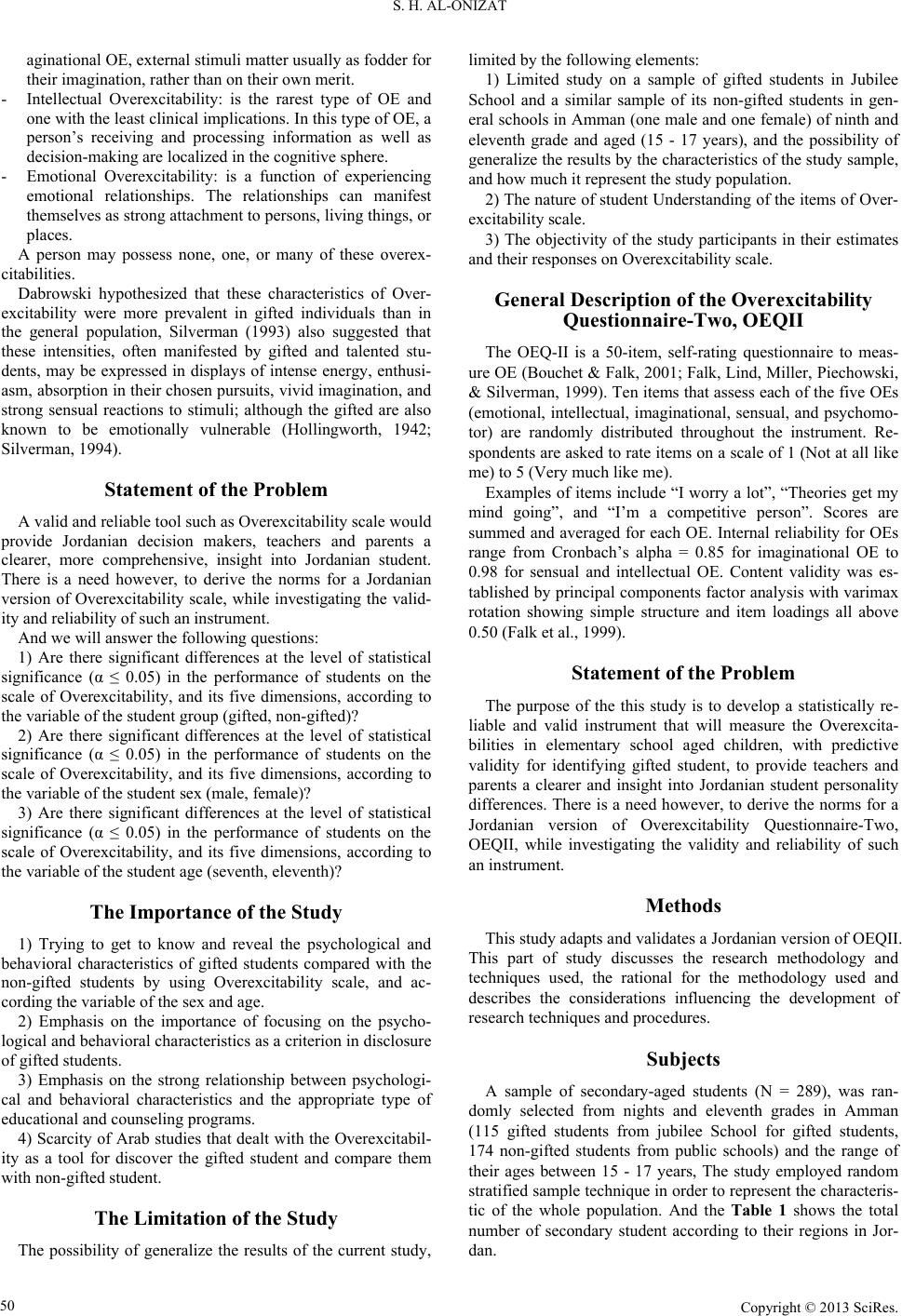
S. H. AL-ONIZAT
aginational OE, external stimuli matter usually as fodder for
their imagination, rather than on their own merit.
- Intellectual Overexcitability: is the rarest type of OE and
one with the least clinical implications. In this type of OE, a
person’s receiving and processing information as well as
decision-making are localized in the cognitive sphere.
- Emotional Overexcitability: is a function of experiencing
emotional relationships. The relationships can manifest
themselves as strong attachment to persons, living things, or
places.
A person may possess none, one, or many of these overex-
citabilities.
Dabrowski hypothesized that these characteristics of Over-
excitability were more prevalent in gifted individuals than in
the general population, Silverman (1993) also suggested that
these intensities, often manifested by gifted and talented stu-
dents, may be expressed in displays of intense energy, enthusi-
asm, absorption in their chosen pursuits, vivid imagination, and
strong sensual reactions to stimuli; although the gifted are also
known to be emotionally vulnerable (Hollingworth, 1942;
Silverman, 1994).
Statement of the Problem
A valid and reliable tool such as Overexcitability scale would
provide Jordanian decision makers, teachers and parents a
clearer, more comprehensive, insight into Jordanian student.
There is a need however, to derive the norms for a Jordanian
version of Overexcitability scale, while investigating the valid-
ity and reliability of such an instrument.
And we will answer the following questions:
1) Are there significant differences at the level of statistical
significance (α ≤ 0.05) in the performance of students on the
scale of Overexcitability, and its five dimensions, according to
the variable of the student group (gifted, non-gifted)?
2) Are there significant differences at the level of statistical
significance (α ≤ 0.05) in the performance of students on the
scale of Overexcitability, and its five dimensions, according to
the variable of the student sex (male, female)?
3) Are there significant differences at the level of statistical
significance (α ≤ 0.05) in the performance of students on the
scale of Overexcitability, and its five dimensions, according to
the variable of the student age (seventh, eleventh)?
The Importance of the Study
1) Trying to get to know and reveal the psychological and
behavioral characteristics of gifted students compared with the
non-gifted students by using Overexcitability scale, and ac-
cording the variable of the sex and age.
2) Emphasis on the importance of focusing on the psycho-
logical and behavioral characteristics as a criterion in disclosure
of gifted students.
3) Emphasis on the strong relationship between psychologi-
cal and behavioral characteristics and the appropriate type of
educational and counseling programs.
4) Scarcity of Arab studies that dealt with the Overexcitabil-
ity as a tool for discover the gifted student and compare them
with non-gifted student.
The Limitation of the Study
The possibility of generalize the results of the current study,
limited by the following elements:
1) Limited study on a sample of gifted students in Jubilee
School and a similar sample of its non-gifted students in gen-
eral schools in Amman (one male and one female) of ninth and
eleventh grade and aged (15 - 17 years), and the possibility of
generalize the results by the characteristics of the study sample,
and how much it represent the study population.
2) The nature of student Understanding of the items of Over-
excitability scale.
3) The objectivity of the study participants in their estimates
and their responses on Overexcitability scale.
General Description of the Overexcitability
Questionnaire-Two, OEQII
The OEQ-II is a 50-item, self-rating questionnaire to meas-
ure OE (Bouchet & Falk, 2001; Falk, Lind, Miller, Piechowski,
& Silverman, 1999). Ten items that assess each of the five OEs
(emotional, intellectual, imaginational, sensual, and psychomo-
tor) are randomly distributed throughout the instrument. Re-
spondents are asked to rate items on a scale of 1 (Not at all like
me) to 5 (Very much like me).
Examples of items include “I worry a lot”, “Theories get my
mind going”, and “I’m a competitive person”. Scores are
summed and averaged for each OE. Internal reliability for OEs
range from Cronbach’s alpha = 0.85 for imaginational OE to
0.98 for sensual and intellectual OE. Content validity was es-
tablished by principal components factor analysis with varimax
rotation showing simple structure and item loadings all above
0.50 (Falk et al., 1999).
Statement of the Problem
The purpose of the this study is to develop a statistically re-
liable and valid instrument that will measure the Overexcita-
bilities in elementary school aged children, with predictive
validity for identifying gifted student, to provide teachers and
parents a clearer and insight into Jordanian student personality
differences. There is a need however, to derive the norms for a
Jordanian version of Overexcitability Questionnaire-Two,
OEQII, while investigating the validity and reliability of such
an instrument.
Methods
This study adapts and validates a Jordanian version of OEQII.
This part of study discusses the research methodology and
techniques used, the rational for the methodology used and
describes the considerations influencing the development of
research techniques and procedures.
Subjects
A sample of secondary-aged students (N = 289), was ran-
domly selected from nights and eleventh grades in Amman
(115 gifted students from jubilee School for gifted students,
174 non-gifted students from public schools) and the range of
their ages between 15 - 17 years, The study employed random
stratified sample technique in order to represent the characteris-
tic of the whole population. And the Table 1 shows the total
number of secondary student according to their regions in Jor-
dan.
Copyright © 2013 SciRes.
50